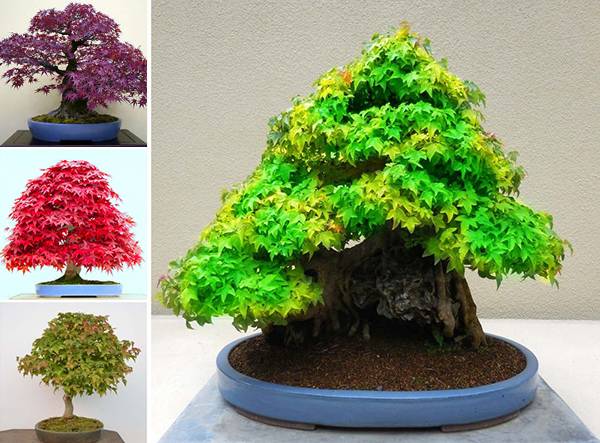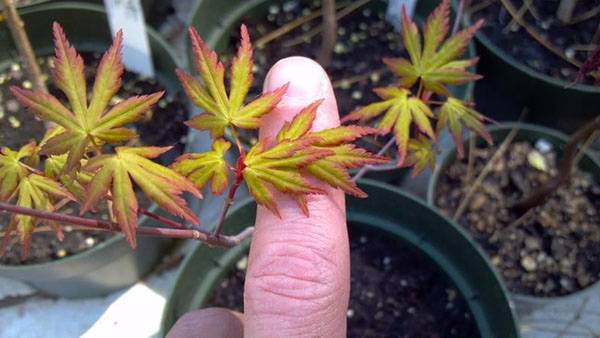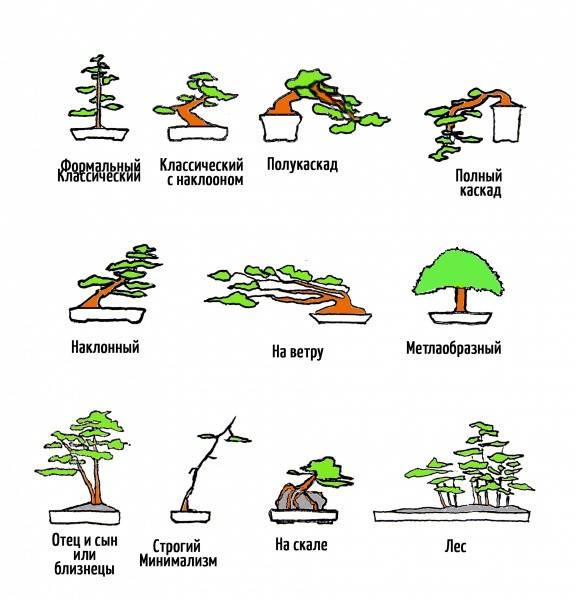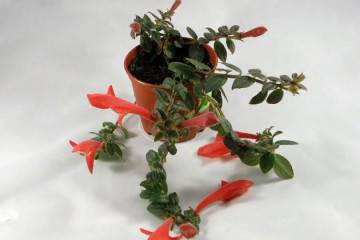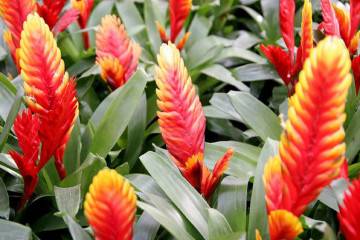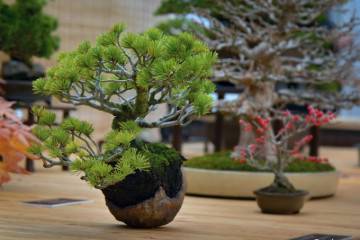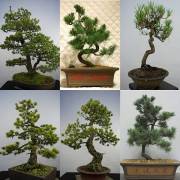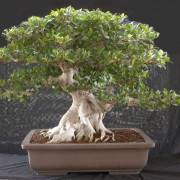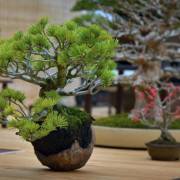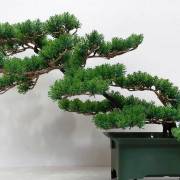Bonsai maple - growing from seeds at home
Content:
The modern art of bonsai combines the customs and traditions of the peoples of Japan and China, dating back to BC. The literal translation of "bonsai" is "grown in a dish." The traditions under which only samurai were allowed to grow bonsai were gradually filled with new meanings, symbols, meanings and technologies. Art has expanded, modernized and for more than a century it has become available to the average inhabitant of eastern countries.
In 1914, the first exhibition was held in Tokyo, the capital of Japan, at which miniature copies of common trees were presented. The world community was inspired by the example of the Japanese, and the art of bonsai spread throughout the planet. Florists do not just grow a mini-plant, but form certain shapes of trunks, roots and crowns. Below in the article we will talk about maple bonsai.
Maples for bonsai
Maple bonsai is a deciduous Japanese art. Unlike coniferous miniature evergreens, maple can have different foliage shades, sometimes changing color as it grows.
Suitable varieties
Maple varieties ideal for indoor growing:
- palm-shaped;
- rocky;
- ash-leaved;
- field;
- plane-leaved.
It is in these varieties of trees that the leaves grow in proportion to the size required for bonsai. It should be remembered that maple bonsai has the same characteristics as regular relatives. This means that in autumn all the leaves fall off, and the plant goes into a state of winter dormancy. Maple is also quite common, the crown of which is stained red. But the common red maple has more demanding care requirements, as its leaves are low in chlorophyll.
Maple Bonsai Styles
According to treatises on Japanese art, house trees should look like they are sprouting in the wild. Throughout the life of the plant, and especially the first years after planting, the grower purposefully gives the originally chosen shape. The styles adopted in bonsai equate the strength and resistance of the plant to the pressure of the environment.
There are about 20 basic styles, but they are not specific examples of the future of bonsai. Florists strive to give a shape that matches the name. According to the styles, the tree may have regular, symmetrical features or look like it was being bent by a strong wind.
How to choose seeds and plant the right maple tree for bonsai
Planting material can be purchased in the form of seeds, cuttings or young germinated trees in specialized stores. But you can also prepare seedlings or seeds yourself. Planting material can be purchased from nurseries or botanical gardens from a full-size tree. Dwarf sizes are acquired later, during the growth process when pruning. Cuttings can also be obtained after cutting a finished tree.
The soil for the bonsai, as well as the container, are prepared in advance. To prepare the substrate, it is necessary to mix humus, black soil and river sand in equal proportions. Each of the parts must be disinfected separately using heat treatment or treatment with special preparations, such as phytosporin. This is done to prevent the plant from various diseases and the appearance of insects.
The tray or dish in which the bonsai is planned to grow is also prepared in advance. The container is thoroughly washed, disinfected and rinsed. It is also advisable to subject the ceramic container to heat treatment just before planting. You also need to prepare drainage holes to avoid stagnant water. To prevent the soil from spilling out, the holes can be covered with a mesh.
Before planting, the seeds must be kept in damp sand for at least 24 hours. It is not worth planting immediately in a prepared container, you can germinate in an ordinary pot. The prepared seeds are placed in the nutritious soil at a distance of 1-2 cm between the grains, then pressed down and covered with a layer of soil 3 cm. After abundant watering, the grains should be covered with a transparent film or glass cap. Under these conditions, bonsai maple seeds will receive sufficient moisture and sunshine.
Bonsai cuttings
If a grafting method is chosen for growing miniature maple, then the time to reach a full-fledged plant is reduced by about 12 months. In addition, this method requires much less energy consumption. If we compare the method of germinating grains with the method of cuttings, the latter is much easier to use.
To plant maple shoots for bonsai, it is necessary to install drainage at the bottom of the pot and only then fill the nutritious soil. The lower edges of the cuttings are cut with a thin sharp knife at an angle of 45 ° and placed in the substrate to a depth of 2-3 cm. The distance between the cuttings should be at least 2 cm. After planting, the cuttings are kept constantly moist for the first 3-4 weeks. It is important to keep the moisture level at an optimal level without overflowing or overdrying the seedlings.
Maple Bonsai Care
In order for bonsai to grow and develop in accordance with the rules and traditions of Japanese art, many factors must be looked after and observed on a daily basis. First of all, you need to determine the location of the tree. At home, in the conservatory, or outdoors, Japanese maple trees should receive daily sunshine. It is best if this happens in the early hours, when the air has not yet warmed up after a cool night. Direct sunlight can damage leaves, their color, branches and roots. For the rest of the day, sunlight for bonsai should be diffused.
The root system of the bonsai maple is not protected by the earth, so the plant is not able to withstand low temperatures. If in winter it drops below zero by at least 5 °, then the wintering place should be located in a heated room.
If you do not follow the watering conditions, this can lead to the development of various diseases, as well as to drying out or rotting of the roots. Therefore, it is necessary to carefully calculate the acidity and the amount of water. At normal temperatures, watering is done daily, on hot days it increases up to 2 times.If humidity rises in the area where the bonsai grows, then the amount of water for daily irrigation can be privately reduced.
To give the Japanese maple the correct shape it needs, the tree needs to be pruned from its branches and roots. Generally, global pruning occurs at the end of the summer season. It is at this time that the juices of the plant are not involved in the growth of the crown and are able to favorably affect the healing of the wound.
Root pruning occurs when the plant is transplanted. As a rule, bonsai are transplanted no more than once every two years. When transplanting, the volume of the container is slightly increased. The root system and crown must be trimmed at the same time to evenly distribute the strength of the plant.
Crown formation
Bonsai crown pruning is done in order to give the tree a certain shape. Their observance is not strictly necessary, but the general component must comply with the canons of bonsai art. The most common examples of crown formation:
- fan or broom (hokidachi);
- formal vertical (tekkan);
- informal vertical (moyogi);
- oblique (shakkan);
- a tree bent by the wind (fukinagashi);
- roots on the rock (sekiyoyu).
Diseases and pests that pose a threat
Japanese maple is a plant that is resistant to various kinds of pests and diseases that other types of bonsai can be susceptible to. However, in the spring, miniature maple can be attacked by aphids. They are easily destroyed with insecticides.
Another attack is a fungus that can completely destroy a tree. To prevent this from happening, when pruning and transplanting and other care, it is necessary to follow safety rules, as well as thoroughly disinfect instruments and materials.
In ancient China and Japan, it was believed that by growing bonsai, one can feel like a god, feeling the power over nature. People achieved enlightenment by contemplating the beauty created by their own hands for hours. Now this highest point of pleasure is available to mere mortals. Having decided to grow maple bonsai once, you will forever become a fan of this ancient art.

